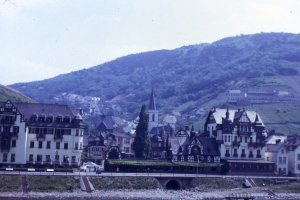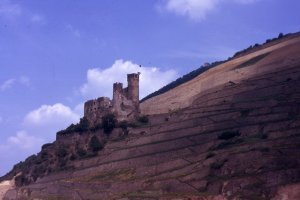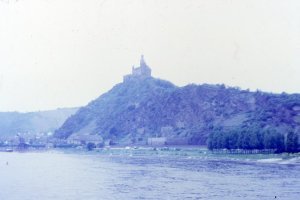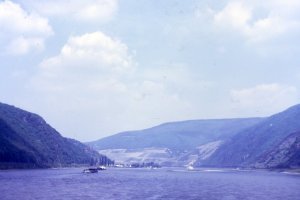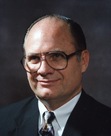Europe on 5-10 Nervous Breakdowns a Day (27)
DAY 26 – TUESDAY, MAY 21, 1974 – A TRIP DOWN THE RHINE
We got up about 6:00, leaving the hotel a little after 6:30 to make our way to the train station. We breakfasted again on milk and bananas, then caught the 7:27 train to Mainz. When we got there, I asked the guy at the information window where the Rhine steamer is. He said that one has to take one of the taxis, which were in front of the station. We got in one and told the female driver to take us to the Rhine steamer. She said, “Vas ist das schemer?” I tried “boat” and that rang a bell. The taxi trip cost 8 marks ($3.20) so our “free” trip was already costing us.
We were fairly early so had no problem getting on the boat. The girls picked a spot on the top deck, next to the rail. The seats are a kind of deck chair. The steamer itself is quite elaborate: three dining rooms, a souvenir shop, a money-exchange booth, toilets, etc. After we got on, the place filled up with school kids.
Our steamer went to Koln (Cologne)—only a few hours by train, but twelve hours by boat. The aim is a slow leisurely cruise where one can see the old towns on each side plus the old castles on the hillsides. (At the beginning of the trip, we passed a castle every few kilometers.)
The Rhine seems cleaner than some of the rivers we have seen.
Perhaps that’s because it does not run through many major cities. There is much commercial traffic on the river plus many cruise ships. Some of the cruise ships go all the way from Basel, Switzerland, to Amsterdam; these have cabins for the travelers. Some of the commercial boats spend days on the river and are outfitted for families. Sometimes a car is parked on board near the family’s cabin with clotheslines attached here and there. Two barges even had fenced-in swing sets on top of the cabins. It looked strange to see kids swinging back and forth as they floated down the river.
It was sunny and very hot before the boat set off, but once it started, the wind off the water was cold. I figured we would all suffer from sore throats and sunburns.
We had brought snack stuff for lunch. Shortly afterwards, Jo and I moved inside and I wrote a letter to my parents. Among other things, I wrote, “At the moment, Jo’s head is resting on my lap and I am using her back for a writing desk. It has been a pleasant trip. We are too tired to fully enjoy it, but it is still nice. Please let everyone know we are still alive and eager to get back to Australia. (If I were to ask Jo, she could tell me how many days, hours, and minutes until we get back.)” (Later: We were about half way through our trip.)
The toilets cost eight cents and washing your hands cost eight cents. An attendant sitting in the washroom took your money. The first time I went, after paying, I read the tiny notice carefully. It said that the hand washing was free but the soap and paper towel cost eight cents. After that, we washed without soap and without using the paper towel.
‘Most everywhere in Europe it costs to use the WC—if you can find one. One of the more ingenious setups was where they had a vending machine that sold a package consisting of a paper towel, soap, and toilet paper. That eliminated the attendant and/or coin slots in the door of the stalls.
The last part of the Rhine trip was not nearly as pretty or as interesting as the first part. The railroad runs alongside the Rhine so one could probably just go part way and then get on the train for the remainder of the journey. If one doesn’t have the funds to eat in the dining rooms, there isn’t much to do. As time went by, we each had a little cup of ice cream (28 cents each). Then Cokes (50 cents each). Later, a frankfurter and a piece of bread (92 cents each). I had to get some film ($8.00+). If I were to do it again, I would bring lots of food and water and film, something good to read, a cap and jacket, and suntan lotion—and then just lean back and enjoy.
We arrived in Kohn an hour late, but were ready to get off when the boat docked. We hurried off with our bags and caught the first taxi. (The train station was nearby but too far to walk.) The driver didn’t start his meter. I asked about it and best I could tell, he said, “Fixed price.” He charged us five marks (about $2.00). I have a hard time not feeling that people take advantage of me because I’m “a rich American.”
In the station I got a Coke for everyone (60 cents each). And there was a charge for our bags. So, in spite of the fact that the Rhine trip was free and there would be no charge for our housing and evening meal (at the Nilands’), we still spent $32.00 that day. Even basic survival in Europe is expensive.
We dashed into the station and found our train, so caught it okay. Forty minutes brought us to Hagen and—wonder of wonders—Phil Niland was there to meet us. He had gotten my letters. Phil’s wife Matilda is German, but he is Australian. We knew them in Australia.
We thought Hagen would be a quaint little German village, but it turned out to be a bustling modern industrial town of 200,000.
The Nilands had just moved into their new house April 21. It is built beside Matilda’s parents’ home. Matilda had kept something hot for us and while we were eating, her father came over. I couldn’t keep my eyes open so I went upstairs and conked out. Later I got up and went to bed properly. We were going to get up early to do some sightseeing in the area.

